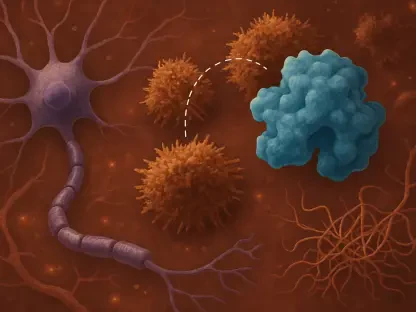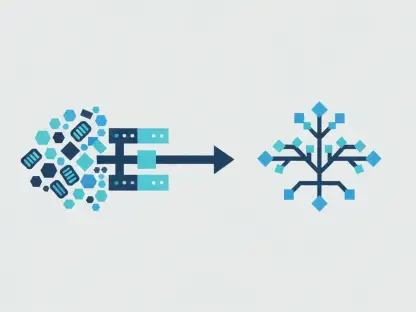Glioblastoma multiforme, an aggressive form of brain cancer, has long been a formidable challenge in the medical field. With patient survival rates stagnating around 15 to 18 months, the need for innovative treatment approaches is critical. NeOnc Technologies, under the leadership of Dr. Thomas Chen, is pioneering a novel drug delivery system that promises to transform the landscape of brain cancer treatment. Their groundbreaking efforts could offer new hope for patients who have seen limited advancements in their battle against this deadly disease.
The Challenge of Treating Glioblastoma
Glioblastoma’s aggressive nature and the protective blood-brain barrier have historically limited the effectiveness of traditional treatments. The blood-brain barrier, while essential for protecting the brain from harmful substances, also restricts therapeutic drugs from reaching brain tumors effectively. This dual-edged sword has necessitated the search for alternative delivery methods that can bypass this barrier. Addressing this challenge is crucial for making substantial strides in glioblastoma therapy.
Dr. Chen’s innovative approach leverages the nasal-brain delivery method, inspired by the natural olfactory system. This method utilizes the olfactory nerve’s ability to transport inhaled substances directly to the brain, offering a potential solution to the limitations imposed by the blood-brain barrier. By capitalizing on this unique biological pathway, NeOnc Technologies aims to overcome one of the most significant obstacles in brain cancer treatment, potentially revolutionizing how these therapies are administered.
The Nasal-Brain Delivery Method
The concept behind the nasal-brain delivery method is relatively straightforward. By using a nasal spray, patients can inhale therapeutic compounds, which are then absorbed by the olfactory nerve. This nerve, responsible for our sense of smell, delivers these compounds directly to the brain, targeting glioblastoma cells. This method not only increases the bioavailability of the drug at the tumor site but also minimizes systemic exposure, potentially reducing side effects. This approach represents a significant departure from traditional drug delivery methods and highlights the importance of innovative thinking in medical research.
Currently, this approach is in development-stage clinical trials with promising results. Patients administer the treatment at home using a nasal nebulizer four times a day for about twenty minutes each session. This protocol aims to reduce the physical burden on patients by minimizing the need for frequent hospital visits, thereby improving their quality of life during treatment. The convenience and ease of use of this system could have far-reaching implications for patient compliance and overall treatment success.
Clinical Trials and Initial Results
The initial outcomes of the clinical trials have been encouraging. Reports indicate extended survival rates and, in some cases, significant tumor regression observable via MRI scans. Remarkably, some patients have survived three to four years post-treatment, a substantial improvement compared to the typical prognosis. These advancements underscore the potential effectiveness of the nasal-brain delivery system and its role in offering renewed hope to glioblastoma patients.
These promising results have caught the attention of the Food and Drug Administration (FDA), leading to a Fast Track Designation. This designation is intended to expedite the review and approval process for therapies addressing serious medical conditions with unmet needs. Following the initial success in Phase 2A trials, NeOnc Technologies anticipates transitioning to Phase 2B, involving a larger cohort of approximately 70 patients. Continued positive outcomes in these trials could pave the way for making the drug widely available to patients, marking a significant milestone in the fight against glioblastoma.
Expanding Applications to Pediatric Brain Cancer
In addition to glioblastoma, NeOnc Technologies is exploring the potential applications of their delivery system for pediatric brain cancer. Although still in the early stages of trial phases, this approach holds substantial promise for improving outcomes in children suffering from brain cancer. The extension of this innovative method to pediatric cases marks another significant milestone in their research, offering hope for a vulnerable patient population that often faces limited treatment options.
Dr. Thomas Chen’s contributions as a professor of neurosurgery and pathology, combined with his directorship of Surgical Neuro-Oncology at the University of Southern California, lend significant credibility and expertise to NeOnc Technologies. His leadership in navigating the complexities of brain cancer treatment through innovative scientific methods underscores a broader trend in medical research: the integration of novel delivery systems to improve therapeutic efficacy. The potential success of this technology could have wide-reaching implications, not only for brain cancer but also for other conditions requiring targeted drug delivery to the brain.
A Paradigm Shift in Brain Cancer Treatment
Glioblastoma multiforme is an aggressive type of brain cancer that has posed significant challenges in the medical world. Despite countless efforts, patient survival rates have remained disappointingly low, typically around 15 to 18 months. This bleak prognosis underscores the urgent necessity for innovative treatment methods.
Enter NeOnc Technologies, led by Dr. Thomas Chen. This pioneering company is developing a revolutionary drug delivery system with the potential to significantly alter the fight against brain cancer. Dr. Chen and his team are making strides towards offering new hope to patients who have faced limited treatment options and stagnant survival rates until now. NeOnc Technologies’ groundbreaking approach could provide a much-needed breakthrough, potentially extending patient survival and improving quality of life. Their work represents a beacon of hope in a field that desperately needs advancements, giving patients and their families a chance to envision a future with new possibilities.









